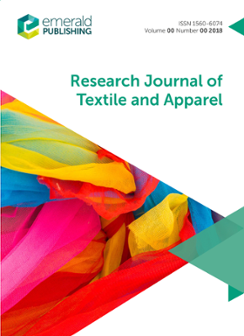Table of contents
Spectral Measurement and Data Processing of Textile Surface Reflection
Yinlong SunThis paper reports a study on reflection measurement of a textile surface. The measurement was made involving spatial directions and wavelength. To integrate a spectral detector…
Evaluating Textile Fabric Color Variation by Scanner
A. Shams-NateriThe purpose of this publication is to describe the possibility of using a scanner for the evaluation of color variation or color difference of textile fabrics. Initially, the…
Finite Element Modelling of the Warp Knitted Structure
Argyro Kallivretaki, Savvas Vassiliadis, Mirela Blaga, Christopher ProvatidisThe finite element modelling of the Charmeuse warp knitted fabrics is the main subject of this paper. The proposed model consists of a three-dimensional representation of the warp…
Textronic Model of Clothing Considering Changes in Its Thermoinsulating Properties
Michał Frydrysiak, Stefan Ziegler, Krzysztof GniotekThis work presents a model of the human – clothing system and describes the mechanisms of heat exchange. The first stage of the investigation focused on the elaboration of a…
Modelling of Virtual Garment Design in 3D
Agnieszka Cichocka, Pascal Bruniaux, Vladan KoncarThis paper presents an introduction to the modelling of virtual garment design process in 3D… Our global project of virtual clothing design, along with the conception of a virtual…
Inter Fiber Frictional Model
Shahram Nowrouzieh, Artan Sinoimeri, Jean-Yves Drean, Richard Frydrych, Jean-Paul GourlotOne of the effective forces in the textile process is friction. A new and simple device is developed in order to quantify the friction forces during a quasi-static fibre slippage…
Effects of Sampling Methods on Detection of Yarn Quality
C.W. Kan, M.P. LauQuality control is essential to ensure product quality in the textile industry and the way of sampling can determine its effectiveness as the facts regarding the quality are…
A Soft Computing Model for Predicting Yarn Tenacity
Ting Chen, Chong Zhang, Xia Chen, Liqing LiA soft computing model for predicting yarn tenacity from fiber properties and yarn parameters is developed. Because the number of samples is limited, the artificial neural network…
Models of Textile Magnetic Core
Janusz ZiębaThis paper introduces two types of textile magnetic elements: mechanical-magnetic and circuital. Textile magnetic cores consist of elementary monofilament magnetic fibres. Textile…
A New Approach to Agility in The Apparel Industry
Antonela Curteza, Adela FloreaPresently, worldwide apparel companies are facing a turbulent market caused by permanent globalization, sustained economic growth, consolidation of industries and intense…

ISSN:
1560-6074Online date, start – end:
1997Copyright Holder:
Emerald Publishing LimitedOpen Access:
hybridEditor:
- Prof Gail Taylor